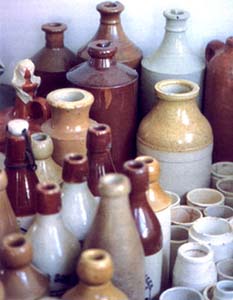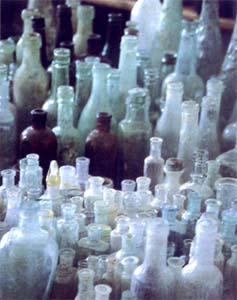
Diana Wemyss
TREVOR'S PLEASURE IS THE PITS
A collecting habit inspired by the rubbish dump
There's no doubt about it, once the bug bites collecting can become an all-consuming obsession. It usually starts with something as insignificant as a single piece which gets augmented by another slightly different item and then another and another, and so it goes on until the hunt for something rare and unusual becomes a passionate treasure hunt. Over time amateur collectors become hugely knowledgeable about what they are collecting.
Of course, in many fields of collecting the promise of financial gain is a very strong driving force . The little bargain in the junk shop on the corner could turn out to be rare and highly valuable and if you know that and the person selling it doesn't the triumph of knowledge over ignorance is satisfaction in itself. Time too puts a value on old things. Antique furniture has steadily increased in value over the years and in some cases shown better returns than the stock markets.
Unlike most collectors who find their "treasures" by digging around in second-hand shops, the late Mr and Mrs Pieter van Zyl of Cape Town acquired their collection in a rather unusual way. They spent their leisure time literally digging, like the treasure hunters of yore, in old rubbish dumps. They were looking for old bottles, sometimes called 'poor man's antiques' because unless they are very rare or very old, bottles are of no great value and do not, on the whole, fetch astronomical prices.
Mr van Zyl worked for the SA Defence Force and when a rifle range was built in what today is Blue Downs and Belhar, old bits and pieces of the past were unearthed; bottles, pots, dolls, pipes and broken pottery. These pieces of social history were uncovered in what was once a Victorian rubbish dump created by a young forester, Joseph Storr Lister. He was given the task of finding a way to control the shifting sand dunes on the outskirts of Cape Town and Port Elizabeth. While still in his early 20s he came up with a solution which was both cheap and simple. He devised a system of spreading a layer of municipal garbage, consisting of street sweepings, the contents of dustbins, kitchen garbage and stable litter over large areas of the dunes. Seeds of selected trees were sown and these grew quickly and bound the sand. The household refuse naturally also contained things as pumpkin and other vegetable seeds which germinated and grew providing food for the convict labour force. The stable sweepings grew crops of oats which provided fodder for the mules transporting the refuse. The same method for reclaiming the dunes was used in Port Elizabeth, where 9 144 metric tons of refuse was used to claim 1 378 hectares of drift sand between 1893 and 1899.
It was from these old dumps in the 1960s and 1970s that collectors began to uncover bottles and other bits and pieces of Victorian domestic life. The dump at Port Elizabeth has now been depleted and housing estates have been built on the one in Cape Town. The National Monuments Act today prohibits people from digging or disturbing historical and archaeological sites including shipwrecks, rubbish dumps and demolished buildings.
The Van Zyls, it would seem, placed more importance on the finding than on the display of their treasures and didn't seem to have followed up with any further research. Most of their finds remained packed in boxes for 25 years after they moved from Cape Town to Robertson. The Van Zyls did, however, inspire another couple, AL and Ethleen Lastovicia. The Lastovicias are today arguably the most knowledgeable bottle collectors in South Africa and their two books, Bottles and Bygones and Ginger Beer Bottles: An Illustrated Guide For the South African Collector have become essential references for collectors and models for similiar publications in other parts of the world. It was from their first book that we learnt about the Victorian rubbish dumps and how they originated.
"It is easy to collect" says Al. "But if you really want to enhance your collecting you have to research, display and share your knowledge." Al rates bottle collecting as the third most popular hobby in America after philately (stamps) and numismatics (coins and medals).
The Van Zyl's collection was recently auctioned by Ashbey's Galleries in Cape Town and Al and Ethleen helped to sort 6 000 bottles into lots. The Van Zyls amassed possibly the largest old bottle collection in this country - 6 000 glass and stoneware bottles of all shapes, sizes and colours, as well as clay pipes, jars, pot lids, dolls heads and ginger jars of all sizes.The sale of bottles, pot lids, etc at the Ashbey's auction totalled R 36 625. Highlights Included:
- Lot of 10 blob-top ginger-beer bottles R 1 700.
- Lot of 7 champagne ginger-beer bottles, R 1 300.
- Transfer-printed ointment jars varied between R 300 - R 500 each.
- Blue glass pharmacy bottles, R 400 - R 700 for a lot
- Collection of clay pipes (damaged) R 550.
- Collection of blue and white 18th-century Dutch tiles, R 2 200.
Apart from such valuable bottles. there are also more humorous collectables such as miniature bottles of Roses lime juice, a bottle of after-shave lotion shaped like a train and bottles with marble stoppers invented by a Mr Codd for beer in 1875. (Beer was once known as 'wollop' hence the term 'a load of Codd's wollop', which in turn became an expression for someone who was talking nonsense, presumably because that's what beer drinkers tended to talk when they'd emptied a few of Mr Codds' bottles.)
According to Al some bottles have fetched astonishing prices. For example, a bottle bought at an auction in Paarl in may 1980 was resold in England shortly afterwards for £200 000. And at a bottle auction in America in 1975 an early 19th-century glass, pint -sized whiskey flask sold for $26 500.
As with any large collecting field, bottles are best collected according to specialty. For instance, some collections are built up around types of bottles while others are collected for their colour. According to AL embossed bottles are interesting and misprints highly prized. Free-blown wine bottles from the 17th and 18th century with irregularities are valuable treasures, but are seldom found in South Africa.
The idea as with all fields of collecting, is to own the most pristine examples of their type. Irregularities and imperfections created in the manufacturing process are quite collectable. 'Sick' bottles, on the other hand are not and are worth less. The dull and scaly white appearance usually caused by the chemical action of the soil or the water in which they were buried is not desirable and these bottles are worthless to serious collectors. Blemishes also drastically reduce the value of rare bottles.



- Left Picture- a few of the ginger-beer bottles from the Pieter van Zyl collection auctioned at Ashbey's.
- Middle Picture - Thousands of bottles collected from the Cape's Victorian rubbish dump.
- Right Picture - A couple of unusual bottles stand out among a collection of blue bottles.

The late Mr Pieter van Zyl photographed in August 1973 digging on the old rubbish dump on the Cape Flats.